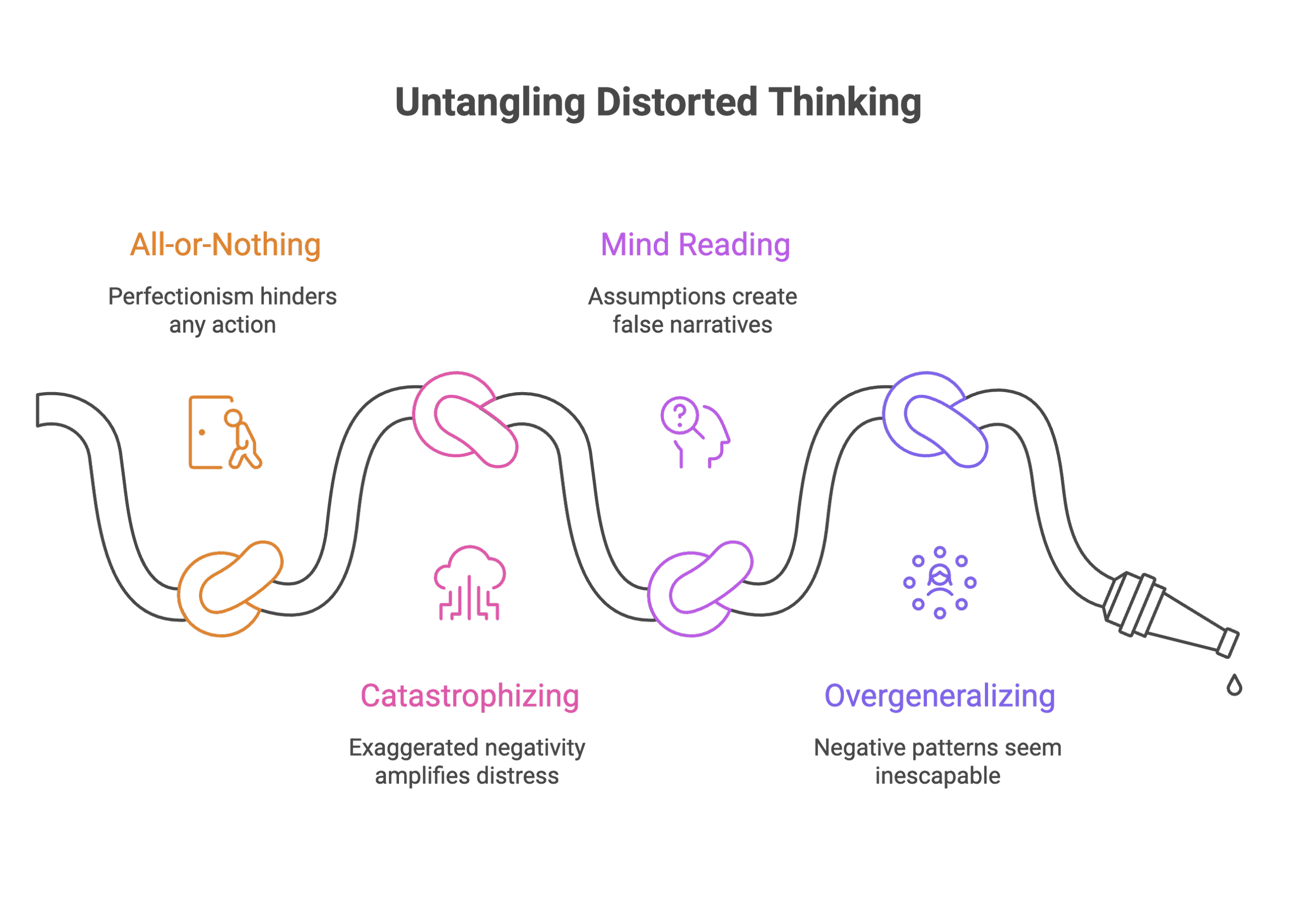What Is Cognitive Behavioral Therapy (CBT)? A Simple Explanation That Actually Makes Sense
Why We’re Talking About CBT
Let’s be honest—most conversations about therapy get complicated fast. Between all the acronyms, theories, and “official” terms, it can start to sound like you need a psychology degree just to understand your own brain.
That’s exactly why we’re here. At Mental Health Made Simple, we break down big mental health concepts into practical, everyday language so you can understand how they work and how they might help you.
Today, we’re unpacking one of the most common (and often misunderstood) therapy approaches: Cognitive Behavioral Therapy, or CBT.
And don’t worry—there are no emotional deadlifts required.
The “CrossFit for Your Feelings” Myth
Somewhere along the way, people started describing CBT as if it were mental CrossFit: grueling, intense, and emotionally exhausting. The joke we often make is, “Cognitive Behavioral Therapy is when your therapist makes you do squats while crying about your childhood.”
Thankfully, that’s not how it works.
CBT isn’t about forcing yourself through pain. It’s about understanding how your thoughts, feelings, and behaviors are connected—and learning how small changes in one area can positively influence the others.
In Plain English—What CBT Actually Is
At its core, Cognitive Behavioral Therapy is based on a simple idea:
“Change your thoughts, and your life begins to change too.”
CBT helps you identify unhelpful or distorted thought patterns, understand how those thoughts affect your emotions and behaviors, and then practice reshaping them into something healthier.
Think of it as mental strength training—not to punish yourself, but to retrain your inner dialogue so it stops working against you.
A few everyday examples:
You think, “I always mess things up.” → You feel anxious or defeated → You avoid new opportunities.
In CBT, you learn to pause, identify that thought, and rewrite it: “I made a mistake, but I can learn from it.”
It sounds simple, but over time, this rewiring process helps rebuild emotional resilience and healthier behavior patterns.
Understanding Cognitive Distortions
CBT often begins by identifying cognitive distortions—mental traps that twist how we interpret life. These patterns are sneaky, automatic, and incredibly common.
Some examples include:
All-or-Nothing Thinking: “If I can’t do it perfectly, I shouldn’t do it at all.”
Catastrophizing: “This is the worst thing that’s ever happened.”
Mind Reading: “They must think I’m incompetent.”
Overgeneralizing: “Nothing ever goes right for me.”
When you start noticing these patterns, you can challenge them, reframe them, and take back control of your story.
Common cognitive distortions include All-or-Nothing Thinking, Catastrophizing, Mind Reading, and Overgeneralizing—each one can twist how we see ourselves and the world.
Practical CBT Tools You Can Try
While CBT works best with a trained professional, there are a few simple techniques you can begin exploring:
1. Thought Records
After a tough moment, take a minute to reflect. Write down the situation, what you felt, and what you were thinking. Then ask: “What’s the evidence for and against that thought?” This mental “autopsy” helps you trace your reactions back to their root.
2. Cognitive Restructuring
When you catch yourself believing a lie about your worth, ability, or situation, pause and identify what’s actually true.
Example: “I failed” becomes “I learned what doesn’t work, and I can try again.”
3. Behavioral Activation
Sometimes, action needs to come before motivation. Even if you don’t feel like doing the healthy thing—taking a walk, calling a friend, finishing that project—start anyway. Your emotions often catch up once you get moving.
4. Socratic Questioning
Ask yourself curious questions instead of critical ones:
“What evidence supports this thought?”
“Is there another way to view this situation?”
“If my friend said this about themselves, what would I tell them?”
These small shifts build awareness and self-compassion over time.
How to Know If CBT Is Right for You
CBT isn’t a one-size-fits-all solution. Some people thrive with it; others might need different approaches that dive deeper into emotion, trauma, or attachment.
A good therapist will tailor their methods to your needs instead of forcing one model. You can ask questions like:
“How do you approach therapy?”
“What does change look like to you?”
“If this doesn’t feel like a fit after a few sessions, will you help me find someone who is?”
A trustworthy therapist will welcome these questions—and should be willing to help you find the right fit, even if it’s not with them.
The Bigger Goal—Congruence
Ultimately, the purpose of CBT (and therapy in general) is congruence—helping your inner world match your outer one.
When your thoughts, feelings, and actions align, life feels more whole and less chaotic. Therapy helps you move toward that alignment, one thought at a time.
A Word of Encouragement
If you’ve ever tried therapy and it didn’t work out, don’t write the whole process off. Sometimes the first counselor, style, or method simply isn’t the right match. Finding the right fit can take a few tries—and that’s completely okay.
Every attempt is a step forward in understanding yourself better. And that’s what growth looks like.
What Next?
If this conversation about Cognitive Behavioral Therapy helped simplify something for you, share it with a friend or loved one who might need it.
And if you want to bring practical mental health conversations into your organization, school, or church, explore our growing resource library at mentalhealthmadesimple.life.
We’re here to make mental health simple, approachable, and understandable—one conversation at a time.
Listen to the Full Conversation
🎧 “CBT Isn’t CrossFit for Your Feelings: How Cognitive Behavorial Therapy Actually Works”
The Mental Health Made Simple Podcast — Apple Podcasts, Spotify, and Amazon Music.

